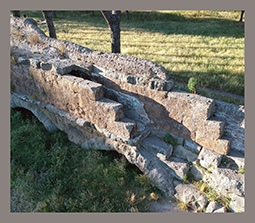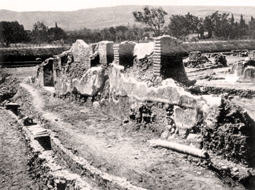Author: P. Montanari
Download article as .pdf: Aqua Marcia: per il cocciopesto un’applicazione sperimentale
 A recent analysis of the Aqua Marcia situated into the Parco degli Acquedotti of Rome (July-September 2019), near the Casale di Roma Vecchia, has lead to the discovery of a new use of cocciopesto. In addition to the cocciopesto coating applied to the specus, Roman architects of the 2nd cent. BC used the same mixture of tile fragments of pozzolana, lime and sand for a different purpose: creating a further waterproofing system. Along the short side of every block of the duct, into the middle, rises a vertical groove filled with cocciopesto. As a matter of fact, this work belongs to the first phase of the aqueduct (144 BC) and seems to represent the oldest manifestation of this particular use in an opus quadratum monument. Both the Aqua Appia and the Anio Vetus, to the best of our knowledge, do not display this construction technique. Although the cocciopesto made its appearance long time before, as shown, for example, in Latium Vetus, by the Segni Project, we can argue that the Aqua Marcia presents a revolutionary solution: the use of cocciopesto within the flutes, added to the linings of the channel, gave the work an extra waterproofing power.
A recent analysis of the Aqua Marcia situated into the Parco degli Acquedotti of Rome (July-September 2019), near the Casale di Roma Vecchia, has lead to the discovery of a new use of cocciopesto. In addition to the cocciopesto coating applied to the specus, Roman architects of the 2nd cent. BC used the same mixture of tile fragments of pozzolana, lime and sand for a different purpose: creating a further waterproofing system. Along the short side of every block of the duct, into the middle, rises a vertical groove filled with cocciopesto. As a matter of fact, this work belongs to the first phase of the aqueduct (144 BC) and seems to represent the oldest manifestation of this particular use in an opus quadratum monument. Both the Aqua Appia and the Anio Vetus, to the best of our knowledge, do not display this construction technique. Although the cocciopesto made its appearance long time before, as shown, for example, in Latium Vetus, by the Segni Project, we can argue that the Aqua Marcia presents a revolutionary solution: the use of cocciopesto within the flutes, added to the linings of the channel, gave the work an extra waterproofing power.

